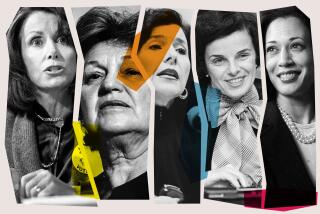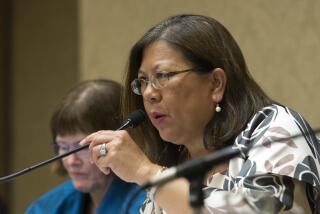A Bar Open to All : The impressive rise of the woman lawyer
- Share via
The election of Margaret M. Morrow last week as the first woman president of the State Bar of California has been hailed with the usual talk of “firsts” and of glass ceilings being broken. But Morrow’s election, on the eve of hearings on the nomination of Ruth Bader Ginsburg to become the second woman justice on the U.S. Supreme Court, brings into the spotlight not just the success of two extraordinary women lawyers but the collective weight of a growing number of women in law. Their concerns about the practice of law and about the letter of the law as it affects women are now front-burner issues inside the profession as well as outside.
Morrow, 42, is a Los Angeles appellate attorney and former president of the Los Angeles County Bar Assn. She was elected to head the State Bar by the most sweeping victory in recent memory and will take office Oct. 10. Among her priorities as president will be encouraging efforts to settle disputes out of court.
Her election to lead the state’s 137,000 lawyers is indeed noteworthy because of her gender. Long a hidebound organization in a hidebound profession, the State Bar was founded in 1927, but because relatively few women were admitted to law school until recent decades few were eligible to join the bar. Now women make up 26% of the bar’s members, and law school enrollments indicate that this percentage will grow in coming years.
These women are raising concerns about the quality of their work life that are very different from those of their older male colleagues. Like Morrow, many try to combine “a heavy professional schedule and . . . roles as a wife and mother.” But they are increasingly voicing frustration with that balancing act and are enlisting their profession in the search for new work arrangements that allow them to be both successful lawyers and involved parents.
The presence of women also has pushed the substance of the law in new directions. Both as a lawyer and as a judge, Ginsburg, for example, has systematically--and successfully--challenged the legal foundation for gender-based discrimination that was once pervasive in state and federal jurisprudence.
Other women (and indeed men) have begun to document gender bias in the daily operation of courts, law firms and other legal institutions. And still others now argue that the law should recognize--and protect--the unique status of women in such issues as childbearing.
Against this background, Margaret Morrow’s election and Ruth Ginsburg’s likely confirmation are not just capstones on the careers of two talented women lawyers; their rise represents the emerging force of a critical mass of women.
More to Read
Get the L.A. Times Politics newsletter
Deeply reported insights into legislation, politics and policy from Sacramento, Washington and beyond. In your inbox twice per week.
You may occasionally receive promotional content from the Los Angeles Times.










